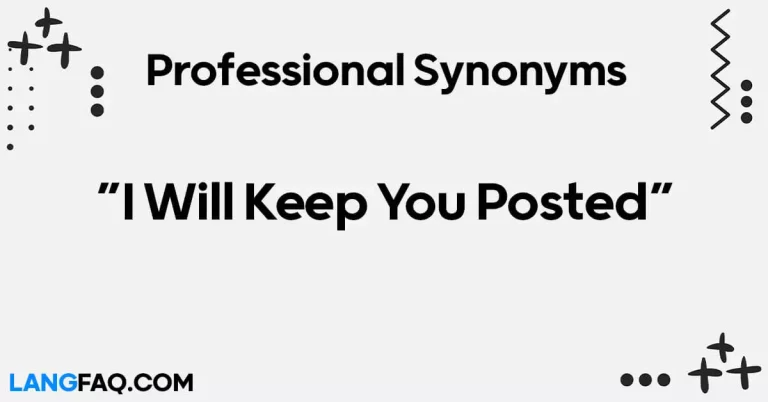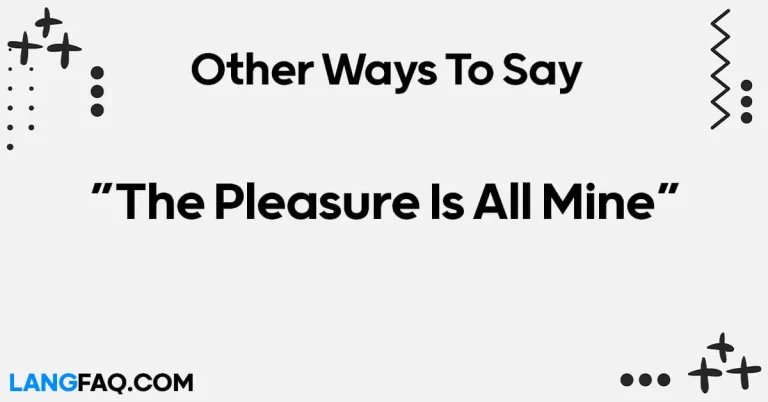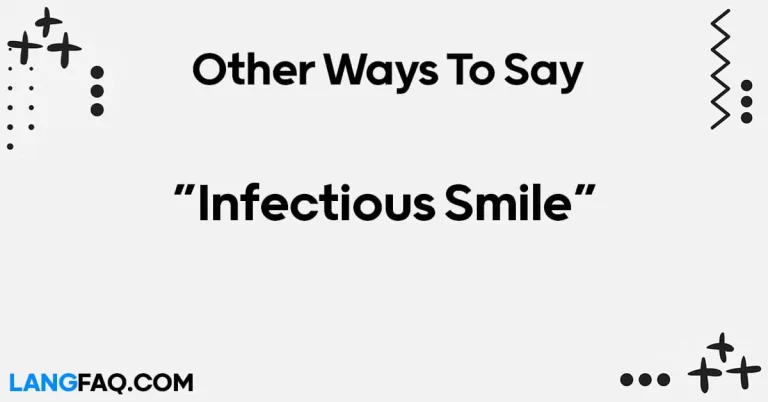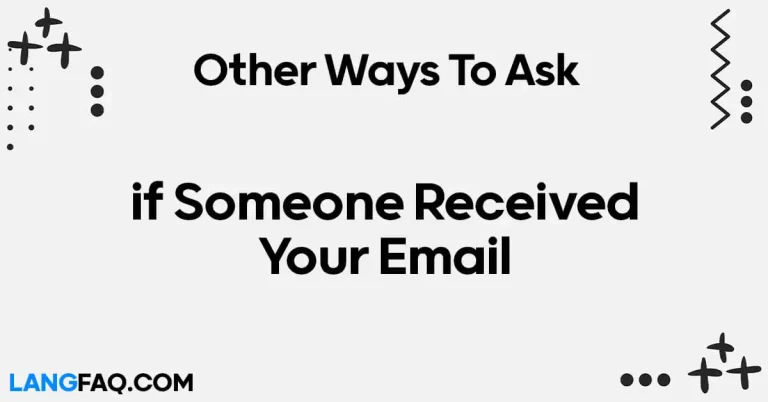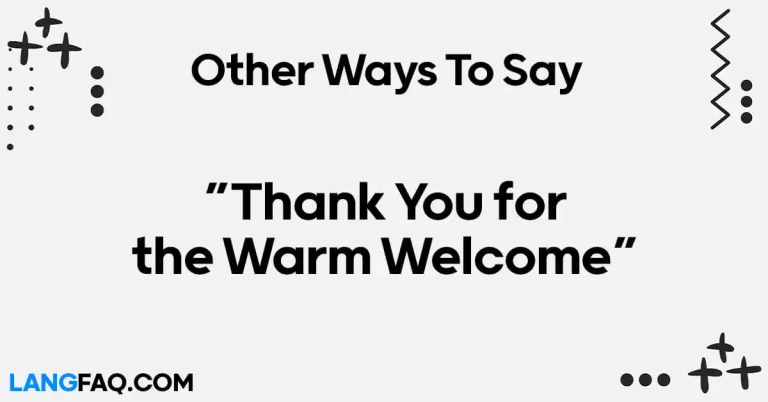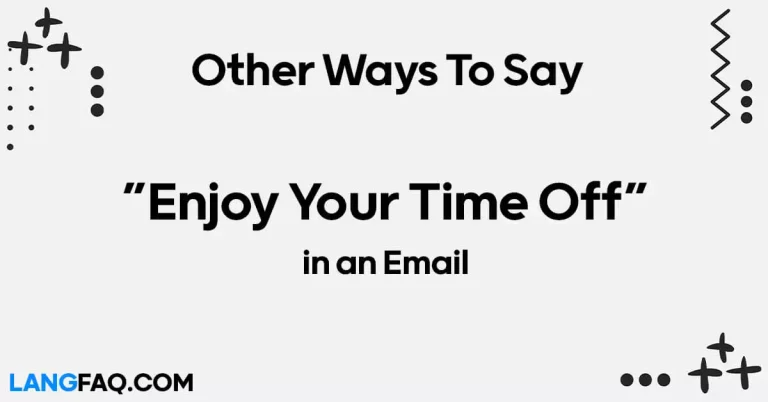Communication is the cornerstone of human interaction, and expressing the intent to connect is an art. In this article, we delve into “12 Other Ways to Say ‘I Am Reaching Out to You’,” exploring diverse strategies to enhance your communication skills. From formal approaches to creative expressions, let’s navigate the realm of effective communication together.
12 Other Ways to Say “I Am Reaching Out to You”
Here are 12 alternative ways to express “I am reaching out to you”:
- I am contacting you to…
- I wanted to get in touch regarding…
- My purpose in reaching out is…
- I’m getting in contact to discuss…
- This is a message to connect about…
- I’m dropping you a line to talk about…
- I’m writing to you in reference to…
- I’m extending a greeting to discuss…
- I’m making an effort to reach you about…
- I’m initiating contact to address…
- I’m sending this message to open a dialogue on…
- I’m getting in contact with you in relation to…
Here’s a table with meanings and examples for the 12 alternative ways to express “I am reaching out to you”:
| Expression | Meaning | Example |
|---|---|---|
| I am contacting you to… | Expressing the purpose of reaching out. | I am contacting you to discuss our upcoming project. |
| I wanted to get in touch regarding… | Indicating the reason for reaching out. | I wanted to get in touch regarding the upcoming event. |
| My purpose in reaching out is… | Clearly stating the intent behind the communication. | My purpose in reaching out is to seek your expertise. |
| I’m getting in contact to discuss… | Initiating communication for a specific discussion. | I’m getting in contact to discuss potential collaboration. |
| This is a message to connect about… | Signifying the nature of the message as a connection. | This is a message to connect about our shared interests. |
| I’m dropping you a line to talk about… | Informally mentioning the reason for communication. | I’m dropping you a line to talk about our upcoming plans. |
| I’m writing to you in reference to… | Highlighting the subject of the communication. | I’m writing to you in reference to the recent proposal. |
| I’m extending a greeting to discuss… | Combining a greeting with the purpose of reaching out. | I’m extending a greeting to discuss our collaborative project. |
| I’m making an effort to reach you about… | Emphasizing the effort put into reaching out. | I’m making an effort to reach you about the new opportunity. |
| I’m initiating contact to address… | Conveying the initiation of communication for a specific matter. | I’m initiating contact to address the concerns raised in the meeting. |
| I’m sending this message to open a dialogue on… | Expressing the intent to start a conversation. | I’m sending this message to open a dialogue on the latest developments. |
| I’m getting in contact with you in relation to… | Establishing a connection based on a specific context. | I’m getting in contact with you in relation to the upcoming conference. |
These diverse expressions offer nuanced ways to convey the act of reaching out. Choosing the right phrase can add depth and clarity to your communication, enhancing the overall effectiveness of your message.
Is It Correct to Say “I Am Reaching Out to You”?
Yes, “I am reaching out to you” is a correct and commonly used phrase in English. This expression is often used in various contexts, both formal and informal, to convey the act of initiating contact, communication, or connection with someone. It is a polite and professional way to express your intention to get in touch or start a conversation.
Examples:
- Formal Context:
- “Dear [Recipient’s Name], I am reaching out to you to discuss the upcoming project collaboration.”
- Informal Context:
- “Hey [Friend’s Name], I am reaching out to you to plan our weekend get-together.”
The phrase is versatile and can be used in professional emails, business communications, networking, or even in personal interactions. It signifies a proactive effort to establish communication and is generally well-received in various settings.
Professional Mail Example With “I Am Reaching Out to You”
Subject: Exploring Collaborative Opportunities
Dear [Recipient’s Name],
I trust this message finds you well. My name is [Your Name], and I am reaching out to you on behalf of [Your Company]. We specialize in [brief description of your company’s expertise or services].
I have been following your work closely and am impressed by your achievements in [relevant field or industry]. Given our shared interests and goals, I believe there may be valuable opportunities for collaboration between [Recipient’s Company] and [Your Company].
I am reaching out to you to propose an initial discussion to explore potential synergies and ways in which our organizations could mutually benefit from a strategic partnership. Your insights and expertise would be highly valuable in shaping the direction of such collaboration.
Could we schedule a brief call or meeting at your earliest convenience to discuss this further? I am available [provide a few options for meeting times] and am flexible to accommodate your schedule.
Thank you for considering this opportunity. I look forward to the possibility of working together and creating a mutually beneficial partnership.
Best regards,
[Your Full Name] [Your Position] [Your Company] [Your Contact Information]
Connecting with You: Building Warm Connections in Professional Correspondence
Effective communication in professional settings often requires a balance between formality and warmth. One way to achieve this is by choosing the right words to convey your message. When opting for a warmer and more engaging approach, the phrase “I am contacting you to” can be transformed into “Connecting with you.” This not only adds a personal touch but also signals an intent to establish a warm connection.
Usage:
- Colleague Context: “I hope this email finds you well. Connecting with you to discuss the upcoming team-building event.”
- Friendship Context: “Hey there! I’ve been meaning to catch up. Connecting with you to plan a weekend getaway.”
Variations:
- Connecting for a Quick Chat
- Reaching Out for a Friendly Discussion
Example Email:
Subject: Exploring Collaboration Opportunities
Hi [Recipient’s Name],
I trust this email finds you in good spirits. Connecting with you to explore potential collaboration opportunities between our teams. Your insights and expertise would be highly valuable in this regard. Could we schedule a brief meeting at your earliest convenience?
Looking forward to our discussion.
Best regards, [Your Name]
Getting in Touch: A Polite Approach to Formal Communication
In formal scenarios, choosing the right words is crucial to convey professionalism and respect for the recipient’s time. The phrase “I wanted to get in touch regarding” can be transformed into a more polished alternative – “Getting in touch.” This slight adjustment maintains formality while subtly indicating a desire to initiate communication.
Usage:
- Colleague Context: “Dear [Recipient’s Name], Getting in touch to discuss the agenda for our upcoming board meeting.”
- Mentor-Mentee Context: “Hello [Mentor’s Name], Getting in touch for guidance on navigating challenges in my current project.”
Variations:
- Reaching Out for Formal Discussion
- Initiating Contact for Professional Insights
Example Email:
Subject: Seeking Your Expertise
Dear [Recipient’s Name],
I trust this email finds you well. Getting in touch to seek your expertise on the recent market trends. Your insights have always been invaluable, and I believe your perspective will greatly contribute to our upcoming strategy session. Could we schedule a meeting to discuss further?
Best regards, [Your Name]
My Purpose in Reaching Out Is: Clearly Articulating Intent in Communication
When precision and clarity are paramount, especially in a professional setting, the phrase “My purpose in reaching out is” provides a direct way to convey your intent. Transforming this into a more concise alternative, “My purpose in reaching out is,” allows you to articulate your goal with transparency.
Usage:
- Business Context: “Dear [Client’s Name], My purpose in reaching out is to finalize the details of our upcoming project launch.”
- Project Management Context: “Hello Team, My purpose in reaching out is to update everyone on the revised timeline for the project.”
Variations:
- Clearly Stating the Purpose
- Defining the Objective of Communication
Example Email:
Subject: Finalizing Project Details
Dear [Client’s Name],
I hope this email finds you well. My purpose in reaching out is to finalize the details of our upcoming project launch. Your input on the proposed timeline and deliverables is crucial at this stage. Could we schedule a brief call to discuss this further?
Thank you for your attention to this matter.
Best regards, [Your Name]
I’m Getting in Contact to Discuss: Navigating Formal Communication with Finesse
In formal and professional environments, the phrase “I’m getting in contact to discuss” can be refined for a more polished communication style. Transforming it into “I’m getting in contact to discuss” maintains the formality required while signaling your intent to engage in a meaningful discussion.
Usage:
- Business Context: “Dear [Recipient’s Name], I’m getting in contact to discuss the contract terms for our upcoming collaboration.”
- Academic Context: “Professor [Last Name], I’m getting in contact to discuss my research proposal and seek your guidance.”
Variations:
- Initiating a Discussion on Formal Matters
- Requesting a Formal Conversation
Example Email:
Subject: Discussion on Contract Terms
Dear [Recipient’s Name],
I trust this message finds you well. I’m getting in contact to discuss the finalized contract terms for our collaboration. Your input on this matter is crucial, and I believe a brief meeting would be beneficial. Could we schedule a time for discussion?
Looking forward to your response.
Best regards, [Your Name]
This is a Message to Connect About: Adding a Personal Touch to Casual Communication
In more casual or friendly contexts, infusing a personal touch into your communication can foster a warmer connection. The phrase “This is a message to connect about” can be transformed into a more informal alternative – “This is a message to connect about.” This approach maintains a friendly tone while conveying your desire to establish a connection.
Usage:
- Friendship Context: “Hey [Friend’s Name], this is a message to connect about our weekend plans. What do you say we catch up for coffee?”
- Casual Networking: “Hi [Contact’s Name], this is a message to connect about potential collaboration opportunities. Let’s grab a virtual coffee and discuss further.”
Variations:
- Dropping a Line for Casual Conversation
- Reaching Out for a Friendly Chat
Example Email:
Subject: Let’s Catch Up Soon
Hey [Friend’s Name],
I hope this message finds you in high spirits. This is a message to connect about our plans for the weekend. How about catching up for coffee or a quick video call? I’d love to hear what you’ve been up to.
Looking forward to your response.
Cheers, [Your Name]
I’m Dropping You a Line to Talk About: Casual Yet Purposeful Communication
In less formal settings, especially among friends or colleagues with a more relaxed relationship, expressing your intent in a casual manner can be refreshing. The phrase “I’m dropping you a line to talk about” can be transformed into a more casual alternative – “I’m dropping you a line to talk about.” This creates a laid-back and approachable tone while maintaining the purpose of your communication.
Usage:
- Friendship Context: “Hey [Friend’s Name], I’m dropping you a line to talk about the crazy weekend plans we’ve been discussing.”
- Team Collaboration: “Hi Team, I’m dropping you a line to talk about some exciting updates in our ongoing project. Let’s gather for a quick team meeting.”
Variations:
- Sending a Casual Message for Discussion
- Reaching Out for an Informal Chat
Example Email:
Subject: Quick Team Update
Hi Team,
I trust everyone is doing well. I’m dropping you a line to talk about some exciting updates in our ongoing project. Let’s gather for a quick team meeting tomorrow at [time] to discuss these developments and brainstorm ideas.
Looking forward to our discussion.
Best, [Your Name]
I’m Writing to You in Reference To: A Polished Approach to Professional Communication
When engaging in formal correspondence, especially in professional or business-related contexts, choosing words that convey respect and precision is essential. The phrase “I’m writing to you in reference to” can be transformed into a more polished alternative – “I’m writing to you in reference to.” This subtle adjustment maintains the formality required in professional communication while signaling the subject of your message.
Usage:
- Business Context: “Dear [Client’s Name], I’m writing to you in reference to the recent changes in our project timeline.”
- Corporate Communication: “Hello [Team], I’m writing to you in reference to the upcoming strategy session. Please find attached the agenda for your review.”
Variations:
- Corresponding Regarding a Formal Matter
- Notifying Regarding a Specific Reference
Example Email:
Subject: Project Timeline Update
Dear [Client’s Name],
I hope this email finds you well. I’m writing to you in reference to the recent changes in our project timeline. Your feedback on the proposed adjustments is crucial at this stage. Could we schedule a brief call to discuss this further?
Thank you for your attention.
Best regards, [Your Name]
I’m Extending a Greeting to Discuss: Balancing Formality and Warmth in Professional Interactions
In professional communications, combining formality with a touch of warmth can enhance the overall tone. The phrase “I’m extending a greeting to discuss” can be refined into a more harmonious alternative – “I’m extending a greeting to discuss.” This approach maintains the professionalism required while creating an inviting atmosphere for discussion.
Usage:
- Client Interaction: “Dear [Client’s Name], I’m extending a greeting to discuss the progress of our ongoing project.”
- Team Collaboration: “Hello Team, I’m extending a greeting to discuss the agenda for our upcoming team-building workshop.”
Variations:
- Formally Initiating a Discussion
- Offering Greetings Before a Professional Conversation
Example Email:
Subject: Progress Discussion
Dear [Client’s Name],
I trust this message finds you well. I’m extending a greeting to discuss the progress of our ongoing project. Your insights and feedback are essential at this stage. Could we arrange a meeting to go over the recent developments?
Looking forward to our discussion.
Best regards, [Your Name]
I’m Making an Effort to Reach You About: Conveying Sincerity in Communication
When expressing sincerity and effort in your communication, especially in professional settings, the phrase “I’m making an effort to reach you about” can be refined for a more polished tone – “I’m making an effort to reach you about.” This modification emphasizes your commitment to the communication while maintaining a professional demeanor.
Usage:
- Professional Inquiry: “Dear [Recipient’s Name], I’m making an effort to reach you about the recent changes in our project strategy.”
- Mentor-Mentee Discussion: “Hello [Mentor’s Name], I’m making an effort to reach you about seeking guidance on my career development.”
Variations:
- Demonstrating Commitment to Professional Communication
- Putting in Effort to Establish Contact
Example Email:
Subject: Seeking Your Guidance
Dear [Mentor’s Name],
I hope this email finds you well. I’m making an effort to reach you about seeking guidance on my career development. Your insights have always been valuable to me, and I believe your advice will greatly contribute to my growth. Could we schedule a brief meeting for this purpose?
Thank you for considering my request.
Best regards, [Your Name]
I’m Initiating Contact to Address: Formal Initiation of Professional Dialogue
In professional settings, initiating contact with a formal tone is essential for clear communication. The phrase “I’m initiating contact to address” can be adjusted into a more succinct alternative – “I’m initiating contact to address.” This maintains formality while clearly expressing the purpose of the communication.
Usage:
- Corporate Communication: “Hello Team, I’m initiating contact to address the upcoming changes in our project structure.”
- Client Interaction: “Dear [Client’s Name], I’m initiating contact to address the concerns raised in our recent meeting.”
Variations:
- Formally Beginning Contact to Discuss
- Officially Initiating Communication for Resolution
Example Email:
Subject: Addressing Project Changes
Hello Team,
I trust everyone is doing well. I’m initiating contact to address the upcoming changes in our project structure. Your input on these adjustments is crucial, and I propose we schedule a team meeting to discuss this further.
Looking forward to your participation.
Best regards, [Your Name]
I’m Sending This Message to Open a Dialogue On: Encouraging Conversation in a Professional Setting
In professional environments, encouraging dialogue is key to effective collaboration. The phrase “I’m sending this message to open a dialogue on” can be refined into a more polished alternative – “I’m sending this message to open a dialogue on.” This subtle adjustment conveys openness to discussion while maintaining a professional demeanor.
Usage:
- Business Context: “Dear [Recipient’s Name], I’m sending this message to open a dialogue on the proposed changes to our marketing strategy.”
- Team Collaboration: “Hello Team, I’m sending this message to open a dialogue on streamlining our project communication processes.”
Variations:
- Formal Invitation to Discuss
- Encouraging Professional Conversation
Example Email:
Subject: Opening a Dialogue on Marketing Strategy
Dear [Recipient’s Name],
I hope this email finds you well. I’m sending this message to open a dialogue on the proposed changes to our marketing strategy. Your insights are crucial to shaping our approach, and I would appreciate your input during a brief discussion. Could we schedule a suitable time for this?
Thank you for your collaboration.
Best regards, [Your Name]
I’m Getting in Contact with You in Relation To: Navigating Professional Correspondence with Precision
In the realm of formal communication, precision is key. The phrase “I’m getting in contact with you in relation to” can be transformed into a more succinct alternative – “I’m getting in contact with you in relation to.” This adjustment maintains a professional tone while clearly indicating the connection between the communication and the subject at hand.
Usage:
- Business Inquiry: “Dear [Client’s Name], I’m getting in contact with you in relation to the recent updates in our project timeline.”
- Professional Networking: “Hello [Contact’s Name], I’m getting in contact with you in relation to exploring potential collaboration opportunities.”
Variations:
- Formally Stating the Relation of Communication
- Establishing a Connection in Professional Correspondence
Example Email:
Subject: Project Timeline Update
Dear [Client’s Name],
I trust this message finds you well. I’m getting in contact with you in relation to the recent updates in our project timeline. Your insights on the proposed adjustments are essential, and I believe a brief meeting would be beneficial. Could we schedule a time to discuss this further?
Looking forward to our discussion.
Best regards, [Your Name]
FAQs
How can I make my outreach more engaging? To enhance engagement, choose expressions like “connecting with you” or “getting in touch” to add warmth and sincerity to your message.
Are creative expressions suitable for professional communication? Yes, when used judiciously. Creativity can make your message memorable, but ensure it aligns with the context and tone of the communication.
Why is follow-up communication important? Follow-up ensures clarity and reinforces your commitment. It’s a vital step to build trust and lasting connections in professional relationships.
Can I use informal expressions in business communication? While it depends on the context, using casual language can add a personal touch. Just ensure it aligns with the professional tone of the conversation.
How do I navigate communication barriers effectively? Sensitivity is key. Acknowledge language barriers and cultural differences, expressing openness and understanding.
Is handwritten correspondence still relevant in business? Absolutely. Handwritten notes stand out in a digital world, conveying sincerity and personal investment in the relationship.
Conclusion
Mastering the art of reaching out is a journey, not a destination. Implement these strategies, adapt them to your unique style, and watch your communication skills flourish. Whether in business or personal connections, your approach defines the quality of your relationships.


